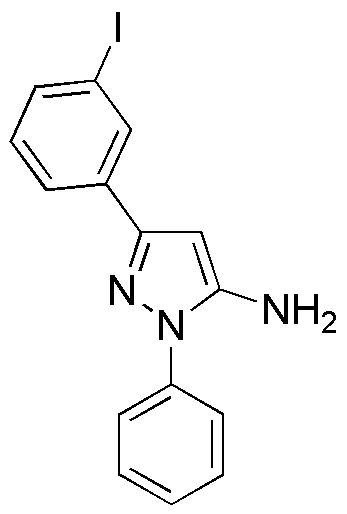5-(3-Iodophenyl)-2-phenyl-2H-pyrazol-3-ylamine is widely utilized in research focused on:
- Pharmaceutical Development: This compound serves as a key intermediate in the synthesis of various pharmaceuticals, particularly in the development of anti-cancer agents due to its ability to inhibit specific cancer cell pathways.
- Biochemical Research: It is used in studies aimed at understanding the mechanisms of action of certain enzymes and receptors, providing insights that can lead to new therapeutic targets.
- Material Science: The compound is explored for its potential in creating novel materials with unique electronic properties, making it valuable in the development of organic semiconductors.
- Diagnostic Applications: Its derivatives are investigated for use in imaging techniques, enhancing the specificity and sensitivity of diagnostic tools in medical settings.
- Environmental Chemistry: It is also studied for its role in tracking and analyzing pollutants, contributing to environmental monitoring and remediation efforts.
General Information
Properties
Safety and Regulations
Applications
5-(3-Iodophenyl)-2-phenyl-2H-pyrazol-3-ylamine is widely utilized in research focused on:
- Pharmaceutical Development: This compound serves as a key intermediate in the synthesis of various pharmaceuticals, particularly in the development of anti-cancer agents due to its ability to inhibit specific cancer cell pathways.
- Biochemical Research: It is used in studies aimed at understanding the mechanisms of action of certain enzymes and receptors, providing insights that can lead to new therapeutic targets.
- Material Science: The compound is explored for its potential in creating novel materials with unique electronic properties, making it valuable in the development of organic semiconductors.
- Diagnostic Applications: Its derivatives are investigated for use in imaging techniques, enhancing the specificity and sensitivity of diagnostic tools in medical settings.
- Environmental Chemistry: It is also studied for its role in tracking and analyzing pollutants, contributing to environmental monitoring and remediation efforts.
Documents
Safety Data Sheets (SDS)
The SDS provides comprehensive safety information on handling, storage, and disposal of the product.
Product Specification (PS)
The PS provides a comprehensive breakdown of the product’s properties, including chemical composition, physical state, purity, and storage requirements. It also details acceptable quality ranges and the product's intended applications.
Certificates of Analysis (COA)
Search for Certificates of Analysis (COA) by entering the products Lot Number. Lot and Batch Numbers can be found on a product’s label following the words ‘Lot’ or ‘Batch’.
*Catalog Number
*Lot Number
Certificates Of Origin (COO)
This COO confirms the country where the product was manufactured, and also details the materials and components used in it and whether it is derived from natural, synthetic, or other specific sources. This certificate may be required for customs, trade, and regulatory compliance.
*Catalog Number
*Lot Number
Safety Data Sheets (SDS)
The SDS provides comprehensive safety information on handling, storage, and disposal of the product.
DownloadProduct Specification (PS)
The PS provides a comprehensive breakdown of the product’s properties, including chemical composition, physical state, purity, and storage requirements. It also details acceptable quality ranges and the product's intended applications.
DownloadCertificates of Analysis (COA)
Search for Certificates of Analysis (COA) by entering the products Lot Number. Lot and Batch Numbers can be found on a product’s label following the words ‘Lot’ or ‘Batch’.
*Catalog Number
*Lot Number
Certificates Of Origin (COO)
This COO confirms the country where the product was manufactured, and also details the materials and components used in it and whether it is derived from natural, synthetic, or other specific sources. This certificate may be required for customs, trade, and regulatory compliance.


